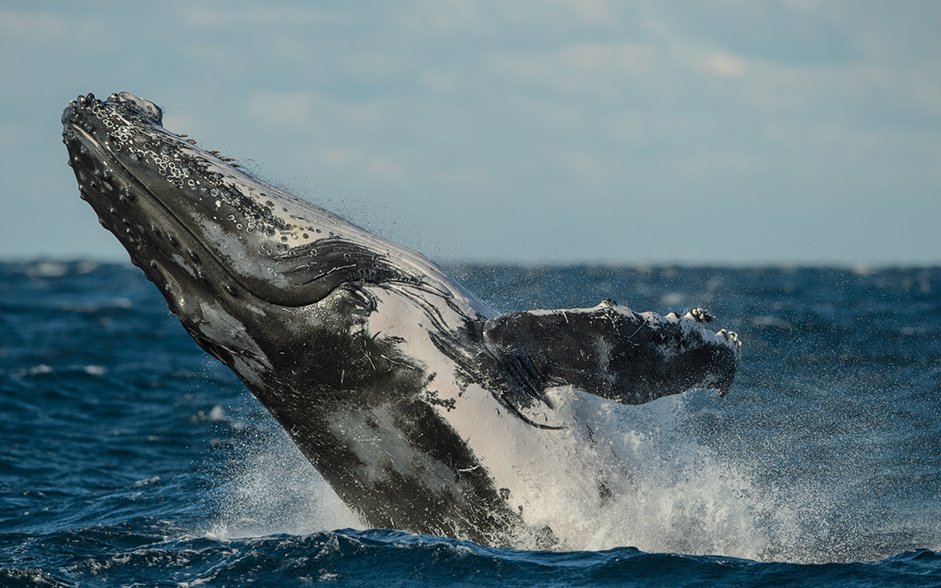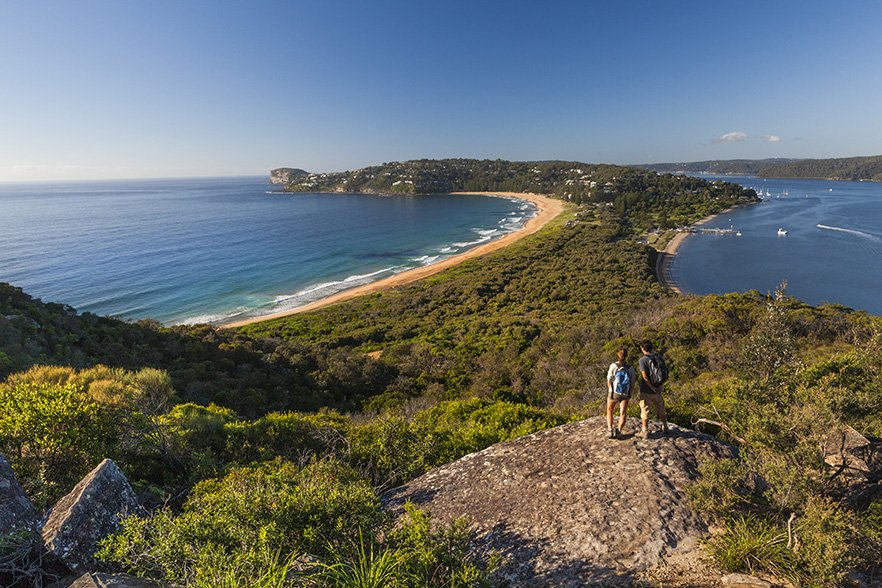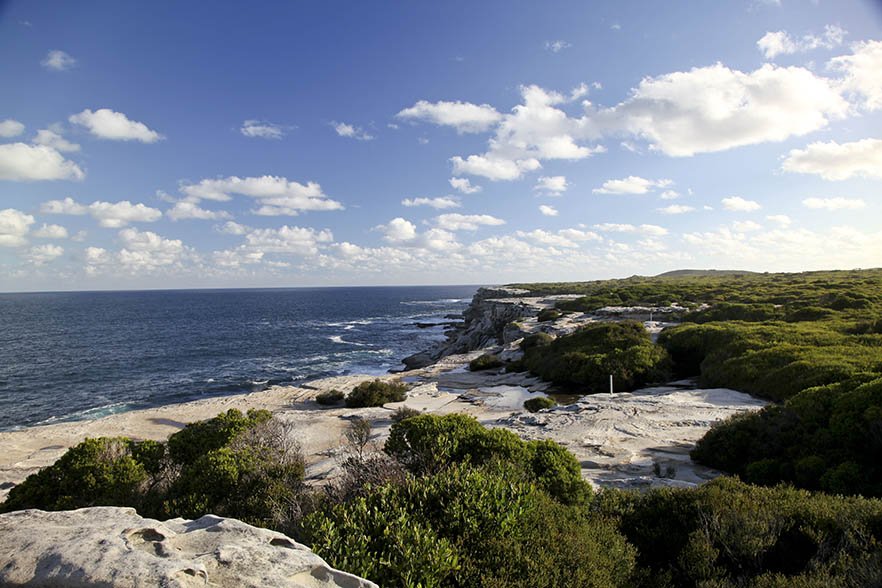Top 8 whale watching spots in NSW

HUMPBACK AND SOUTHERN right whales are most commonly seen migrating up and down the coastline and, while not the largest, they are some of the most magnificent and recognisable species gracing our oceans today.
Whales display striking behaviours during their migration along Australia’s coastline, such as breaching – a form of surfacing where most of a whale’s body leaves the water, and lobtailing – when a whale lifts its tail fluke out of the water before swiftly returning it to make a loud slap.

Humpback whale breaching off the coast of Sydney, NSW. (Image: Trevor Scouten)
With a migration route that averages about 5000km, one of the longest migratory journeys of any mammal on Earth, the ocean beaches and coves of New South Wales are some of the best places to get a glimpse of this remarkable event.
Here are the best eight places in NSW to go whale watching. You can also download the free Wild About Whales app to help locate whales close to you, share your whale watching experience and learn more about different species and characteristics of the whales you’ll be spotting.
1. Eden
The historic whaling town of Eden is bordered by stark rocky cliffs on one side and green national park on the other, making it a prime spot to watch whales as they migrate along the south coast.
Whales are seen here as they make their way to Antarctic waters during their southern migration in September and November.
The town’s history is celebrated each year in November with the Eden Whale Festival.
Once a signal for whalers to harpoon the animal, a siren is now sounded to alert the public and encourage people to watch when a whale passes by.

Top vantage point: Green Cape Lookout in Ben Boyd National Park. Look out for other wildlife here too, including a resident population of fur seals, dolphins, albatross, gannets and sea eagles. (Image: J. Spencer / NSW Office of Environment and Heritage)
2. Port Stephens
Port Stephens is a large natural harbour located in the Hunter Region of New South Wales.
Humpback and southern right whales pass here during their annual migration, but are best seen when moving south in October.
Humpback mothers and their newborn calves are easy to spot from Tomaree Head, which lies 161m above sea level – offering a panoramic view out to sea.

Top vantage point: Tomaree Head. (Image: S. Cohen/NSW Office of Environment and Heritage)
3. Sydney and surrounds
Humpbacks have been known to pop up in Sydney’s iconic harbour during their northern migration.
Weighing about 30,000kg, these huge mammals get their name from their hump-shaped pectoral fins and head.
They are capable of travelling 8km an hour but on a long journey they average only 2km, stopping to rest and socialise along the way.

Top vantage point 1: Barrenjoey Headland at Palm Beach on Sydney’s Northern Beches sits at Sydney’s northern-most point in Ku-ring-gai Chase National Park. A walk up one of the tracks to the historic Barrenjoey Lighthouse will reward with spectacular ocean views and a great opportunity to spot migrating whales. (Image: NSW Office of Environment and Heritage)

Top vantage point 2: Cape Solander in Kamay Botany Bay National Park, just south of the city. Whales have been known to swim as close to 200m from the coast here. Cape Solander features a lookout with a viewing platform. (Image: A Richards/NSW Office of Environment and Heritage)
4. Coffs Harbour
Covering a total area of 71,000 hectares, extending along 75km of coast, The Solitary Islands Marine Park is the third-largest marine protected area in New South Wales.
Humpback whales meet here on their migration from Antarctica. They’re often spotted bReaching, spouting and tail slapping only kilometres from the harbour.
The park is an appealing spot for divers, as iT Is home to a huge variety of colourful marine life.

Top vantage point: Woolgoolga Headland, Coffs Coast Regional Park. Scenic walking tracks lead you to jaw-dropping coastal views up and down the Coffs Coast, all the way to Yuraygir National Park. (Image: B. Webster/NSW Office of Environment and Heritage)
5. Jervis Bay
Humpback, southern right, minke and pilot whales are commonly seen around Jervis Bay, as well as seals, penguins, albatrosses and dolphins.
Some of the best vantage points are around the small coastal town of Culburra, just 18km east of Nowra.
Hyams beach, purported to have the whitest sand in the world, is also renowned for regular sightings of female whales and their calves frolicking in the offshore.

Top vantage point: Seven Mile Beach. (Image: NSW Office of Environment and Heritage)
6. Byron and Tweed
The beachside town of Byron Bay is located in the far north-eastern corner of NSW, 60km north of which lies Tweed Heads.
The strip of coast between the two is inundated with pods of humpbacks during their annual migration from May to November.
Cape Byron Lighthouse sits at Australia’s easternmost point, and a renowned sighting spot, as whales move around the landmass on their southern march.

Top vantage point: Cape Byron Lighthouse sits at Australia’s most easterly point and is a great vantage point for whale watching. (Image: M.Vanderveer/NSW Office of Environment and Heritage)
7. Port Macquarie
The second most easterly point in Australia, Port Macquarie, is a prime spot to see whales begin their migration south, returning to Antarctic waters with their calves to feed.
Humpbacks, the fifth largest mammal on earth, are the most common to be seen here.
Today these majestic creatures are more valuable alive, both environmentally and economically, but were once valued only when dead — mainly for their blubber which was melted down to be used as oil for lamp fuel, lubricants, candles and as a base for perfumes and soaps.

Top vantage point 1: Smoky Cape Lighthouse, Hat Head National Park. (Image: D. Millar/NSW Office of Environment and Heritage)

Top vantage point 2: Diamond Head, Crowdy Bay National Park. (Image: NSW Office of Environment and Heritage)
8. Batemans Bay
With a population of around 15,000, the largest town on the coast south of Nowra is Batemans Bay.
It’s known for its oyster farming, forestry, ecotourism and retail services.
Here you’ll see large numbers of whale’s offshore during their annual migration, some coming within just 3km from land when moving south.
Whale spotting is much easier from land when the whales swim south on their return trip, as the animals seem to move further offshore during their northern migration.

Top vantage point: Depot Beach, Murramarang National Park. (Image: NSW Office of Environment and Heritage)
RELATED:
- Top 10 whale watching spots in Australia
- Why do whales strand themselves?
- 10 of the best Australian wildlife experiences
- VIDEO: Humpback whales behind the scenes




